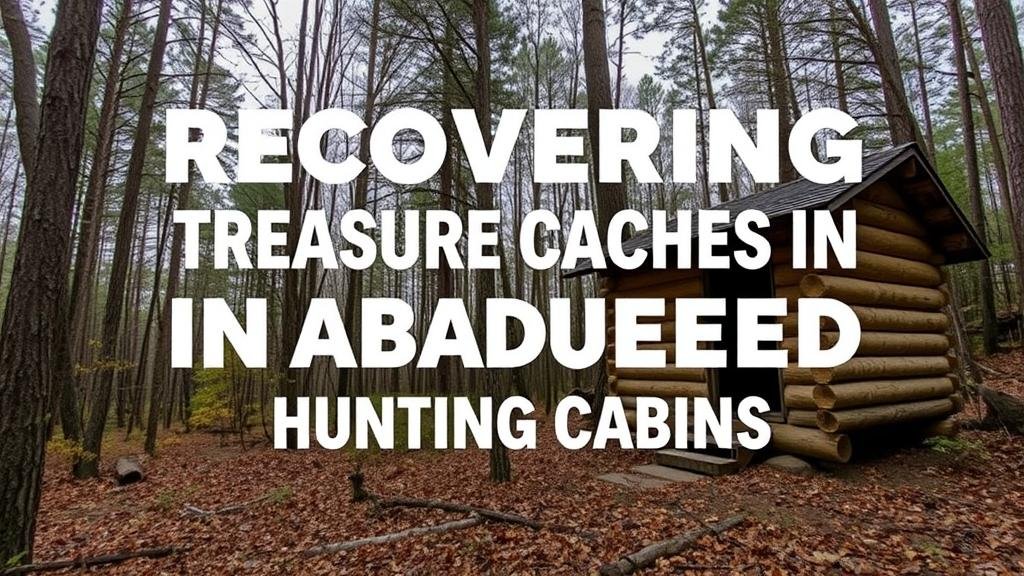Recovering Treasure Caches in Abandoned Hunting Cabins
Recovering Treasure Caches in Abandoned Hunting Cabins
The allure of treasure hunting is timeless, captivating the imaginations of adventurers and historians alike. Abandoned hunting cabins, often relics of a bygone era, can serve as potential treasure troves for those willing to explore their depths. This article delves into the methodologies, historical context, and ethical considerations of recovering treasures from these neglected sites.
Historical Context of Hunting Cabins
Hunting cabins, which date back to the late 19th and early 20th centuries, were commonly used by hunters and outdoor enthusiasts as temporary shelters. Many of these cabins remain standing today, serving as a window into the lives of those who used them. Historical records indicate that hunters often stored valuable equipment, personal belongings, and even food supplies within these cabins, which, over time, have been forgotten or abandoned.
For example, in the Adirondack Mountains of New York, several hunting cabins were left behind as the hunting culture shifted and the land was repurposed for conservation efforts. These cabins may contain artifacts such as old firearms, hunting gear, and personal items that can offer insights into the lives of their former inhabitants.
Methodologies for Recovery
Recovering treasure caches in abandoned hunting cabins requires a strategic approach. following methodologies can be employed:
- Research and Documentation: Prior to venturing out, comprehensive research is essential. Historical maps, photographs, and local archives can provide clues about the cabins past use and any reported treasures. For example, the “Hunting Cabins of the Adirondacks†publication details numerous sites that have been cited in treasure hunting folklore.
- Site Inspection: Upon reaching the cabin, a thorough inspection is crucial. Look for hidden compartments, crawl spaces, and any signs of preserved items that could indicate valuable finds. Utilizing tools like metal detectors can enhance your search capabilities, particularly in detecting old coins or metallic equipment.
- Use of Technology: Advancements in technology, such as ground-penetrating radar (GPR), can allow treasure hunters to locate buried treasures or hidden compartments without invasive digging. These technologies are particularly beneficial when searching in delicate environments where preservation is a priority.
Legal and Ethical Considerations
Before embarking on a treasure recovery expedition, its vital to understand the legalities involved. Abandoned properties often have specific jurisdictional guidelines regarding ownership and relic recovery. For example:
- Ownership Claims: Always ascertain whether the land is privately owned, as trespassing can lead to legal action. Plus, federal and state laws may dictate the handling of recovered historical items. A notable case involved the recovery of artifacts in abandoned mining towns in California, where the discovered items were subject to laws governing archaeological finds.
- Environmental Protection: Many areas contain ecosystems of significance, and disturbing these can result in ecological damage. A hunter in Idaho in 2018 faced legal repercussions for excavating artifacts in a protected environment, underscoring the importance of adhering to conservation laws.
Case Studies and Real-World Applications
Several documented cases provide insightful lessons on recovering treasures from hunting cabins:
- Case Study 1: The Elk Lake Cabin, Colorado: This deserted cabin yielded a trove of vintage hunting gear and personal letters dating back to the 1940s. Researchers utilized documents from the local historical society to identify the cabins original owner, creating a narrative around the recovered items that enriched the historical context.
- Case Study 2: The Mystery of the Lost Trapper’s Cache, Maine: A team of amateur treasure hunters discovered a hidden compartment in an abandoned hunting lodge. After a meticulous search, they uncovered a collection of antique firearms, gold coins, and trappers journals which provided rich historical insights.
Conclusion and Actionable Takeaways
Discovering treasures within abandoned hunting cabins can be a rewarding venture that combines history with adventure. As you prepare for your expedition, remember these key takeaways:
- Conduct thorough research to understand the cabin’s history and potential treasures.
- Employ modern technology and tools for effective recovery efforts.
- Be mindful of legal and ethical considerations to ensure a responsible and respectful exploration.
Ultimately, the process of recovering treasure caches not only involves uncovering material items but also connecting with the historical narratives left behind by those who once inhabited these rustic spaces.



